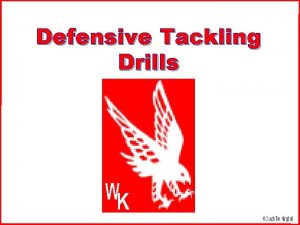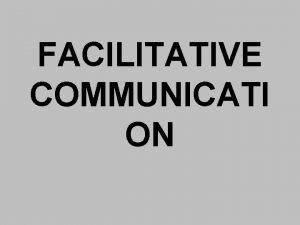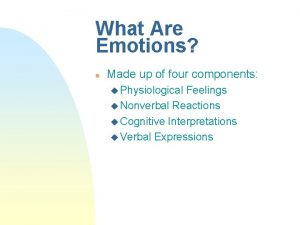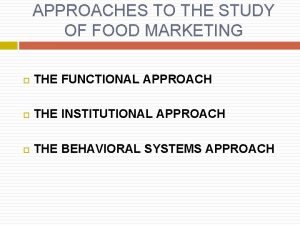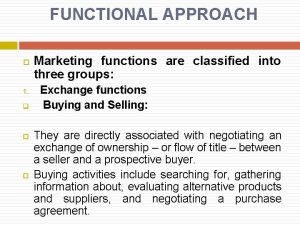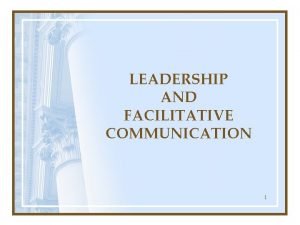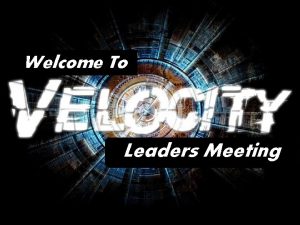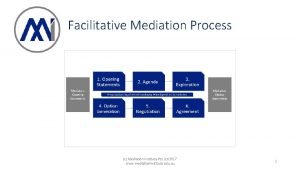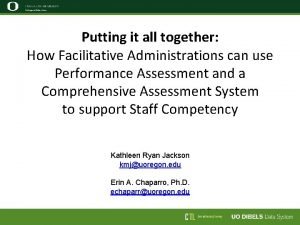PAs as Facilitative Leaders Utilizing the PA to









































- Slides: 41

PAs as Facilitative Leaders: Utilizing the PA to Build a Healthy Organizational Culture Andrea Lombardi, BA, MBA, BHSc. PA, CCPA October 25, 2014

I have no disclosures or conflicts of interest in this presentation.

Objectives 1. 2. 3. Introduce concepts of facilitative leadership Draw parallels between communications skills taught in PA curriculum and facilitative leadership approach Open floor to interactive discussion

Facilitative Leadership Approach �The Skilled Facilitator (2002), Roger Schwarz �The Skilled Facilitator Field Book (2005), Roger Schwarz et al �www. schwarzassociates. com

Facilitative Leadership Approach �Approach to leadership and group decision making �How one thinks is how one leads �Helps leaders shift beliefs, thus changes way they lead

An Illustrative Contrast Unilateral Control �I understand, you don’t. I’m right, you’re wrong. I will win. Facilitative Leadership Approach �I understand some things. So do you. Let’s learn and move forward together.

Unilateral Control Model Mindset Values Behavior Results Assumptions 1. State my views without asking for others’ views and vice versa q Be Right I understand the situation; those who disagree don’t Lower quality decisions § Ineffective solutions § Unnecessary costs q Minimize expression q of negative feelings I am right; those who disagree are wrong 2. Withhold relevant information q q Act rational I have pure motives; those who disagree have questionable motives 3. Speak in general terms and don’t agree on what important words mean Decreased commitment § Poor follow through on decisions § Solutions that don’t stick q Longer implementation times q My feelings and behavior are justified 4. Keep my reasoning private; don’t ask others about their reasoning q q I am not contributing to the problem Strained working relationships § Reduced trust § Defensiveness § Unproductive conflict § Inappropriate dependence on others q Less personal satisfaction § Missed opportunities for growth and development § Unnecessary stress q Decreased learning § Misunderstanding § Denial and blaming others for mistakes § Rigidity q Win, don't lose q q q 5. Act on untested assumptions and inferences as if they were true 6. Control the conversation 7. Focus on positions, not interests 8. Avoid, ease-in to, or save face on difficult issues 9. Use an arbitrary decision rule or don’t discuss it Source: Adapted from Argyris & Schön, 1974, and Action Design, 1997.

Facilitative Leadership Approach Mindset Values q Transparency q Curiosity q Accountability q Informed Choice q Behavior Results Assumptions q I have some information; so do other people q Each of us may see things the others don’t q I may be contributing to the problem 1. State views and ask genuine questions 2. 3. Compassion q Differences are opportunities for learning q People may disagree with me and have pure motives Source: Adapted from Argyris & Schön, 1974, and Action Design, 1997. q Higher quality decisions § Innovative solutions § Cost savings Share all relevant information q Use specific examples and agree on what important words mean Increased commitment § Follow through on decisions § Solutions that stick q Shorter implementation times q Improved working relationships § More trust § Less defensiveness § Productive conflict § Appropriate dependence on others q Greater personal satisfaction § Increased growth and development § Less stress q Increased learning § Greater understanding § Embracing and learning from mistakes § Greater adaptability 4. Explain reasoning and intent 5. Test assumptions and inferences 6. Jointly design next steps 7. Focus on interests, not positions 8. Discuss undiscussable issues 9. Use a decision-making rule that generates the level of commitment needed.

Facilitative Leadership Approach �Mutual ◦ Midset Learning: �Values �Assumptions ◦ “Ground rules” - behaviours ◦ Results

Mutual Learning Mindset: Values �Transparency – sharing relevant info, including thoughts, feelings, intentions �Curiosity – being genuinely interested in others’ views; recognizing other people have info that you do not �Accountability - accepting responsibility for actions and consequences

Mutual Learning Mindset: Values �Informed choice – making decisions and maximizing others’ abilities to make decisions based on relevant info in way that builds commitment �Compassion - willing to temporarily suspend judgment to appreciate your own and others’ situations

Mutual Learning Mindset: Assumptions �I have info and so do other people �People may disagree with me and still have pure motives �I may be contributing to problem �Each of us sees things others do not �Differences are opportunities for learning

Mutual Learning Behaviours 1. 2. 3. 4. 5. 6. 7. 8. 9. State views and ask genuine questions Share all relevant info Use specific examples and agree on what important words mean Explain reasoning and intent Test assumptions and inferences Jointly design next steps Focus on interests, not positions Discuss “undiscussable” issues Use decision making rule that generates commitment level needed

Mutual Learning Results �Provide more guidance than procedural or abstract ground rules �Shorter implementation times �Increased commitment �Higher quality decisions �Increased learning �Improved working relationships �Greater personal satisfaction and well -being

Case Example � You are a PA working in an inpatient ward of a hospital � On a recent initiative conducted by Infection, Prevention and Control, your team scored lowest on proper hand hygiene audit � Your team consists of a physician, nurse, pharmacist, physiotherapist, social worker, and students (and yourself, the PA) � You are meeting with your team

1. State Your Views and Ask Questions © The New Yorker Collection Robert Mankoff from cartoonbank. com. All Rights Reserved.

1. State Your Views and Ask Questions � State your point of view and explain your reasoning � Avoid rhetorical or leading questions ◦ “Do you really think will work? ” � Ask genuine questions that stem from curiosity ◦ “I’m not seeing how this will work because of x. What are you seeing that leads you to think it will work? ”

2. Share All Relevant Information �Help create common pool of info that everyone can use �Relevant information – anything that might affect decision �People underestimate dangers of not sharing relevant information �Feelings ARE relevant

3. Use Specific Examples and Agree What Important Words Mean https: //www. pinterest. com/pin/178103360235496402/

3. Use Specific Examples and Agree What Important Words Mean �We use A LOT of jargon and abbreviations �PAs are team-based, interprofessional clinicians, we don’t just communicate with physicians and nurses! �Shared understanding is key to decision buy-in

4. Explain Your Reasoning and Intent � We are hard-wired to make meaning out of events � Providing explanation helps reduce others making assumptions � Sharing your reasoning more transparent trust � Be curious, and ask others to do same

5. Test Assumptions and Inferences © The New Yorker Collection Cheney from cartoonbank. com. All Rights Reserved.

5. Test Assumptions and Inferences �Assumption – taking something for granted, without any info �Inference – drawing conclusion about things you don’t know, based on things you don’t know �Step 1 – awareness �Step 2 - identify what other person said/did that led to your inference

6. Jointly Design Next Steps and Ways to Test Disagreements �Advocate your point of view, inquire how others see it, jointly craft next step �This invites people to share their thoughts and challenge status quo �Inviting team members to actively participate in designing solution translates into stronger buy-in

7. Focus on Interests Not Positions � Interests – criteria that need to be met in order to solve problem in way people support � Interests motivate people, can be quite fixed � Positions - what people think will serve their motivations, can be very flexible � Focusing on interests creates more options for potential solutions that meet those interests

8. Discuss “Undiscussables”

8. Discuss “Undiscussables” �Issues not discussed openly by team �Relevant to team’s work �Often discussed everywhere else except team �Reduces team’s effectiveness �Most difficult ground rule �Approach with compassion

9. Use a Decision Making Rule that Generates the Level of Commitment Needed Group decision-making process types: 1. 2. 3. 4. 5. � Unilateral Delegative Consultative Democratic Consensus When you need greater commitment to ensure decision is implemented effectively, it makes sense to have greater involvement in process

Communication Skills Taught in PA Curriculum

https: //www. pinterest. com/explore/medical-jokes/

Calgary-Cambridge Guide to the Medical Interview 1. Initiate session ◦ Establish initial rapport ◦ Jointly design reasons for consultation 2. ◦ ◦ ◦ Gather information Encourage patient to tell their story Ask open ended questions Listen attentively Clarify ambiguous terms Encourage patient to express feelings

Calgary-Cambridge Guide to the Medical Interview 3. 4. Provide structure ◦ Structure interview in logical sequence ◦ ◦ ◦ Build relationship Use appropriate body language Develop rapport, use empathy Be non-judgmental Acknowledge views and feelings Share thinking

Calgary-Cambridge Guide to the Medical Interview 5. ◦ ◦ 6. Explain and plan Provide information Elicits patient beliefs, reactions Shared decision making about next steps Ensure all concerns addressed Close session ◦ Summarize session ◦ Final check

Kalamazoo Observation Guide � � Builds relationship: shows interest in patient, uses body language appropriately Opens discussion: asks questions to elicit full set of concerns, negotiates an agenda for visit

Kalamazoo Observation Guide � � Gathers information: asks open-ended questions, clarifies details, asks what is meant by ambiguous language to better understand the patient’s story Shares information Reaches agreement Provides closure

Motivational Interviewing �Conversation about change (counseling, therapy, consultation, method of communication) �Collaborative approach (personcentered, partnership, honors autonomy) �Evocative approach (seeks to call forth person’s own motivation and commitment)

Motivational Interviewing � ◦ ◦ Approach: Open-ended questions Affirmations Reflections Summaries

Discuss utilizing PAs as facilitative leaders to build healthy organizational culture

In Conclusion… � PAs are trained in models for communicating with patients, which are directly aligned with facilitative leadership approach to leadership and team-based decision making � Thus, PAs are well positioned to be facilitative leaders within organizations to help build stronger, healthier working culture

In Conclusion… �This will translate into improved: rapport with physicians and allied health professionals, problem solving, outcomes, quality of work life, patient care, etc. �Will also help strengthen reputation of PAs as leaders, and thus profession in Canada

References � Calgary-Cambridge Guide to the Medical Interview � Kalamazoo Observation Guide � Leadership Retreat, Oncology Program, Sunnybrook Health Sciences Centre (Oct. 15, 2007, Oct. 24, 2008. , Nov. 16 & 17, 2009) � The Skilled Facilitator (2002), Roger Schwarz � The Skilled Facilitator Field Book (2005), Roger Schwarz et al � www. motivationalinterview. org/quick_links/about_ mi. html � www. schwarzassociates. com
 Buty prawdziwego szlachcica pan tadeusz
Buty prawdziwego szlachcica pan tadeusz Tuning out dull topics
Tuning out dull topics Tackle wheel drills
Tackle wheel drills Moteur pas à pas à aimant permanent
Moteur pas à pas à aimant permanent On ne peut pas ne pas communiquer
On ne peut pas ne pas communiquer Poème ne pleure pas devant ma tombe
Poème ne pleure pas devant ma tombe Lecture pas à pas
Lecture pas à pas Facilitative responses
Facilitative responses Fallacy of catastrophic expectations
Fallacy of catastrophic expectations Debilitative emotion
Debilitative emotion Speculative middlemen
Speculative middlemen 7 strategies of communication
7 strategies of communication Elements of teaching and learning
Elements of teaching and learning Classification of marketing function
Classification of marketing function Facilitative communication
Facilitative communication Thế nào là hệ số cao nhất
Thế nào là hệ số cao nhất Hệ hô hấp
Hệ hô hấp Slidetodoc
Slidetodoc Các số nguyên tố
Các số nguyên tố Tư thế ngồi viết
Tư thế ngồi viết đặc điểm cơ thể của người tối cổ
đặc điểm cơ thể của người tối cổ Cách giải mật thư tọa độ
Cách giải mật thư tọa độ Các châu lục và đại dương trên thế giới
Các châu lục và đại dương trên thế giới Tư thế worms-breton
Tư thế worms-breton ưu thế lai là gì
ưu thế lai là gì Thẻ vin
Thẻ vin Cái miệng nó xinh thế
Cái miệng nó xinh thế Các châu lục và đại dương trên thế giới
Các châu lục và đại dương trên thế giới Bổ thể
Bổ thể Từ ngữ thể hiện lòng nhân hậu
Từ ngữ thể hiện lòng nhân hậu Tư thế ngồi viết
Tư thế ngồi viết Thế nào là giọng cùng tên? *
Thế nào là giọng cùng tên? * 101012 bằng
101012 bằng Thể thơ truyền thống
Thể thơ truyền thống Bài hát chúa yêu trần thế alleluia
Bài hát chúa yêu trần thế alleluia Hổ đẻ mỗi lứa mấy con
Hổ đẻ mỗi lứa mấy con đại từ thay thế
đại từ thay thế Diễn thế sinh thái là
Diễn thế sinh thái là Vẽ hình chiếu vuông góc của vật thể sau
Vẽ hình chiếu vuông góc của vật thể sau Công thức tính thế năng
Công thức tính thế năng Tỉ lệ cơ thể trẻ em
Tỉ lệ cơ thể trẻ em Thế nào là mạng điện lắp đặt kiểu nổi
Thế nào là mạng điện lắp đặt kiểu nổi


